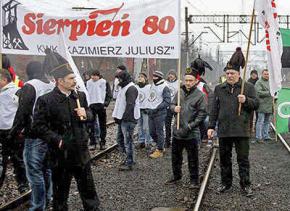Resistance forms in Eastern Europe
Following a recent wave of labor struggles in Poland, reflects on the contradictions of movements for democracy that result in neoliberal reforms and suggests possible lessons from the Polish experience for what comes next in Ukraine, in an article published at the revolutionary socialism in the 21st century website.
THIS HAS been a year of strikes in Poland. From the very first days of January, 20 percent of general practitioners' practices in the country were closed due to strikes. In some areas, these GPs were the only doctors available.
On one level, the doctors were simply striking because they had been burdened with new responsibilities, without a substantial increase in their remuneration. The root cause, however, was the creeping marketization of public health care that has been going on for years. GPs have been turned into entrepreneurs, charged with running the whole practice in return for payments from public health care insurance. Many resent this new role and would rather work for a fixed salary, especially if they operate in "costly" areas with aging populations. The strike eventually ended in a moderate victory for the doctors, with an increase in funding, but it is obvious that the agreement does not resolve the underlying problems.
On January 7, a new strike was already looming. As the government announced restructuring plans for the largest state-run mining company, 100 miners in the Brzeszcze mine refused to leave the mineshaft in protest over the proposed job losses. Four mines were to be closed almost immediately, and nine others "restructured" under new administration. The strike continued until January 17 and involved thousands of people from local communities, who assembled outside of the mines, marched down their streets and on one day blocked the rail tracks leading in and out the largest of Silesian cities, Katowice. Eventually, the strike concluded in a deal where the government promised no pit closures and job losses for those working underground. Hailed as a victory for the unions, the agreement nevertheless allows for privatization, and was met with anger in Zabrze, where protesters attacked the police and attempted to occupy the mine once the deal was announced.

Throughout the strike, the media and the government attempted to present the Silesian miners as a labor aristocracy, enjoying higher pay and better welfare than the growing mass of workers precariously employed in Poland's service sector. State subsidies for mining, the argument went, mean young workers on minimum wage pay taxes so others can enjoy relatively good jobs as miners. The argument was utterly hypocritical as the government's plans involved replacing the closed mines with special economic zones, which are just another form of state subsidy to business. The public saw through the lies, and in a poll for one of the major news networks, 68 percent expressed support for the strike. The high public support was most likely the decisive factor in forcing the government into a compromise in an election year.
The moderate success of the strike encouraged workers at another state-run mining company, JSW, to go on strike on January 28 (see this video report). Their bosses proposed to cut spending by 500 million zlotys, which would translate to pay cuts of around 30 percent, according to union estimates. After 17 days of strike action, the miners at JSW won a number of concessions, including lowering the cuts to 300 million zlotys and the firing of its CEO, who was seen as responsible for the company's poor financial situation.
THESE WILL certainly not be the last strikes of 2015. Other groups are also organizing, among them farmers seeking compensations for Russian embargoes and university teachers in various departments of the humanities. The latter, organized in the Crisis Committee for Polish Humanities, are particularly interesting. While the Crisis Committee campaigns for better working conditions for junior academic staff, they do not shy away from a broader critique of privatization and marketization of higher education. So far, the Crisis Committee has organized a well-publicized conference in February and threatened the government with strikes. It also won a promise from the ZNP, the largest teaching union in Poland, that junior academic staff on part-time and zero-hour contracts will be accepted into the union. Seventy institutes and departments have joined the Crisis Committee already.
These social movements are relevant for Ukraine as well as Poland. The Polish protests have one thing in common--they attempt to resist neoliberal policies which were introduced in the early 1990s by Leszek Balcerowicz. Polish transformation serves as a model for Ukraine's transition, and Balcerowicz himself advises the Ukrainian government. However, the dynamic of a broad movement for democracy resulting in a neoliberal government of the elites is also similar. The government that introduced "shock therapy" in Poland in the 1990s originated as an intellectual leadership within the Solidarity trade union, which in 1980 organized some 9 million workers. By 1989, the leadership realized that its interests contradicted the interests of their working-class followers. They colluded with post-communists to introduce a series of neoliberal reforms that would benefit both groups at the expense of the workers. The Solidarity liberals purposefully limited the growth of Solidarity trade unions, which by 1989 counted only 20 percent of the former membership, and then used their authority to prevent protests against the reforms in early 1990s. It is unsurprising that the official Solidarity rep was driven out of the miners' strike in 1992 on a wheelbarrow.
In 1996, trade unionists in Solidarity finally broke their links with their former leadership, who by then made up the liberal elite in power. Simultaneously, the resistance to unpopular reforms intensified and took more organized forms. In the years 2000-01, strikes in health care shook the country. In 2002, two extremely militant strikes made history. Workers in Ozarow wire factory went on strike from April until November and fought pitched battles with the police and private security, while a similarly radical protest took place in Szczecin shipyard. In 2003, the miners took the first sector-wide action against renewed attempts at mine closures and privatization. The headquarters of the ruling post-communist party, the Democratic Left Alliance, was targeted by protesters, which then led to clashes with the police. Another large-scale miners' protest took place in 2005 in opposition to planned changes in retirement age. Organized labor became a force to be reckoned with once again, even if its influence was limited to the public sector.
IN UKRAINE, we see a similar process in which a liberal leadership of a broad movement for democracy is subsequently brought to government. In the Maidan, some of the oligarchs and sections of the middle class came together with workers to oppose the repressions of Viktor Yanukovych's regime. They called for the introduction of the rule of law and democratic rights, symbolized, perhaps naïvely, by the European Union. As in Poland, the contradictory interests of the former allies became evident soon after the movements' leaders took power.
The protests in Ukraine continue, although it is the war in the east that makes the headlines now. A recent wave of demonstrations in Kiev explicitly targeted the IMF-imposed austerity measures. The Polish experience teaches us that the conflict of interests will become more obvious as the neoliberal reforms are introduced, and resistance will grow. It was surprisingly easy to slow down the pace of reforms in Poland once the unions realized what neoliberalism meant for the workers. While employment in the mines decreased from 415,000 in 1989 to 155,000 in 2000, in the following 15 years only some 50,000 more jobs were lost in the sector. Ukrainian workers will also be able to disrupt the recent reforms, at least temporarily, if they take action (although clearly organized workers in the breakaway regions in the east, where some trade unions are now banned and local trade union leaders have been murdered, are facing particular challenges). Calls for national unity in response to the war can only prevent discontent in the short term, just as, with time, the liberals' influence in Solidarity structures wore off in Poland.
Unfortunately, there is another, more sinister, lesson to be found in the Polish experience of transformation. As liberals and the post-communists became discredited by their complicity in the Polish neoliberal reforms, it was the illiberal nationalist right that capitalized on the popular anger. Similarly, the moderate liberals now in charge of the Ukraine reforms are the most likely to lose public support, while the left is continuously held back because of the common association made between them and the post-communists. The potential for the growth of right-wing influence among organized labor and the general population is a threat not only in itself, but also as an obstacle to confronting neoliberalism openly. The nationalist influence among Polish unions prevents them from confronting the systemic roots of their problems by presenting moral corruption and incomplete implementation of capitalist principles as the sources of working-class impoverishment and exclusion. Until the left is capable of providing political leadership for the popular discontent, the attempts to further neoliberal reforms will continue, both in Poland and Ukraine. The grassroots movements and nationalist right can slow down the reforms, but they cannot provide the ideological challenge to neoliberalism that is required to stop them.
Further reading
For a good overview of the political shift among the Solidarity leadership and their betrayal of the working class, see David Ost, Defeat of Solidarity: Anger and Politics in Post-communist Europe. There is a Polish-language survey of strikes in Poland since 1989--click here. See here and here for more on the anti-austerity protests in Kiev in December and January.
First published at the rs21 website.


